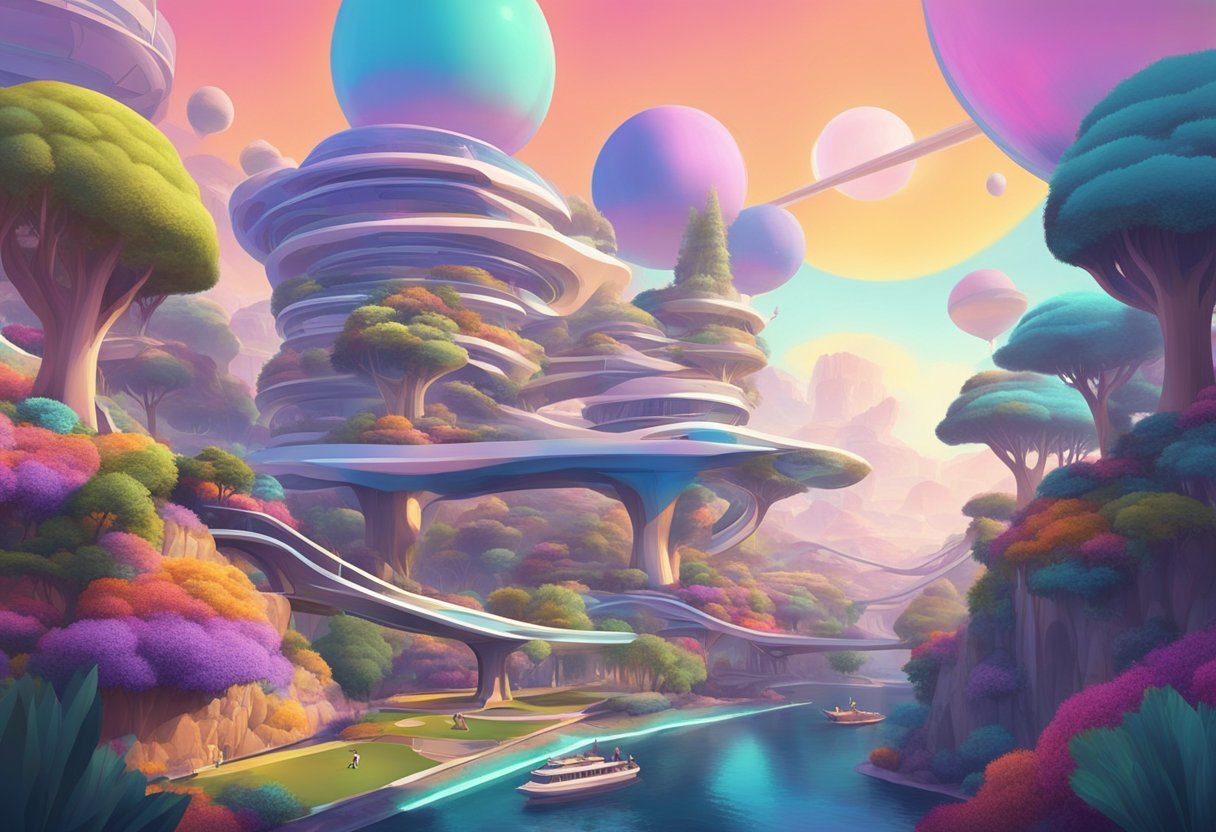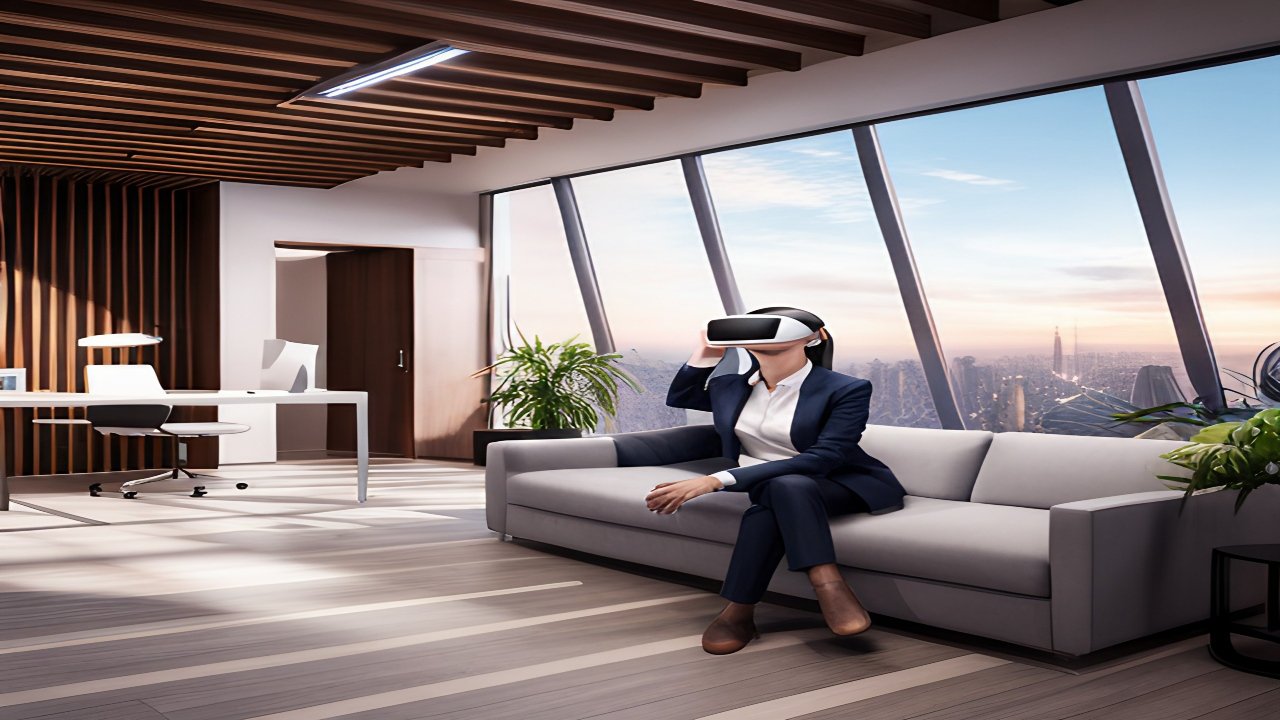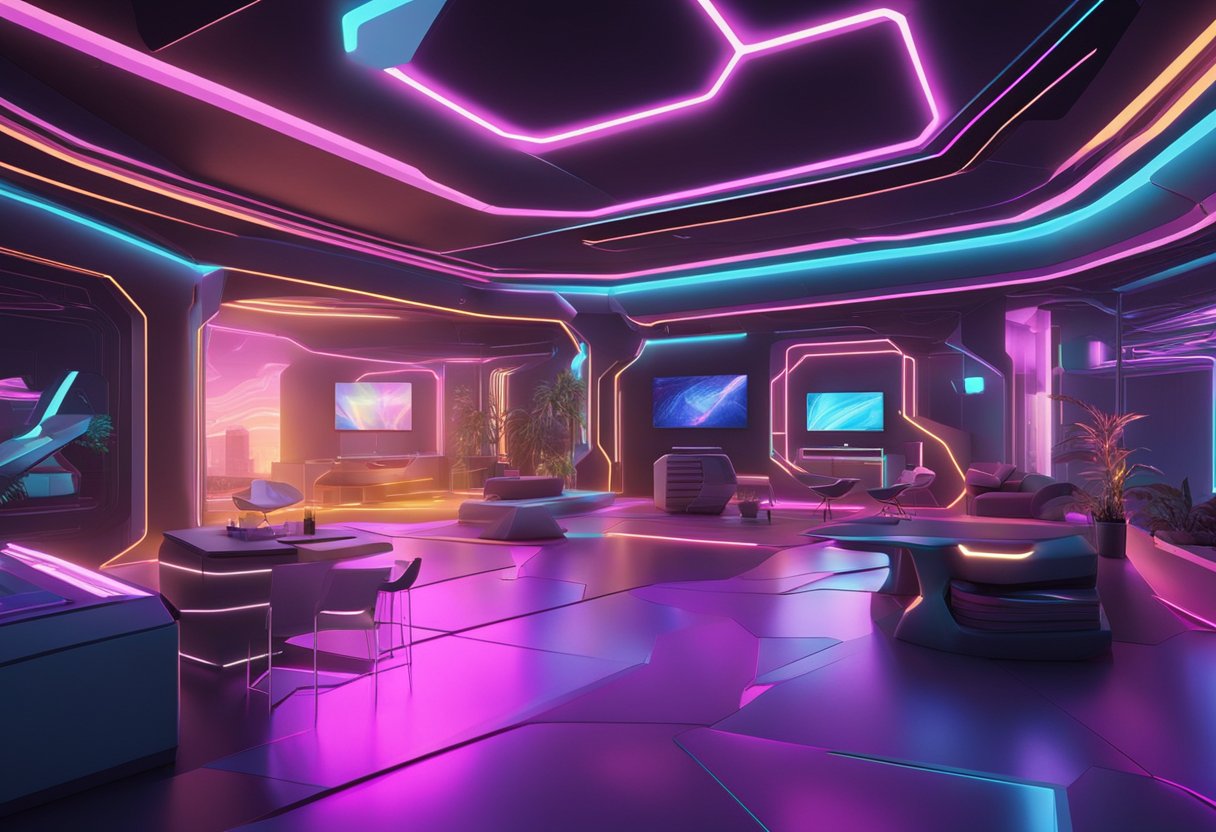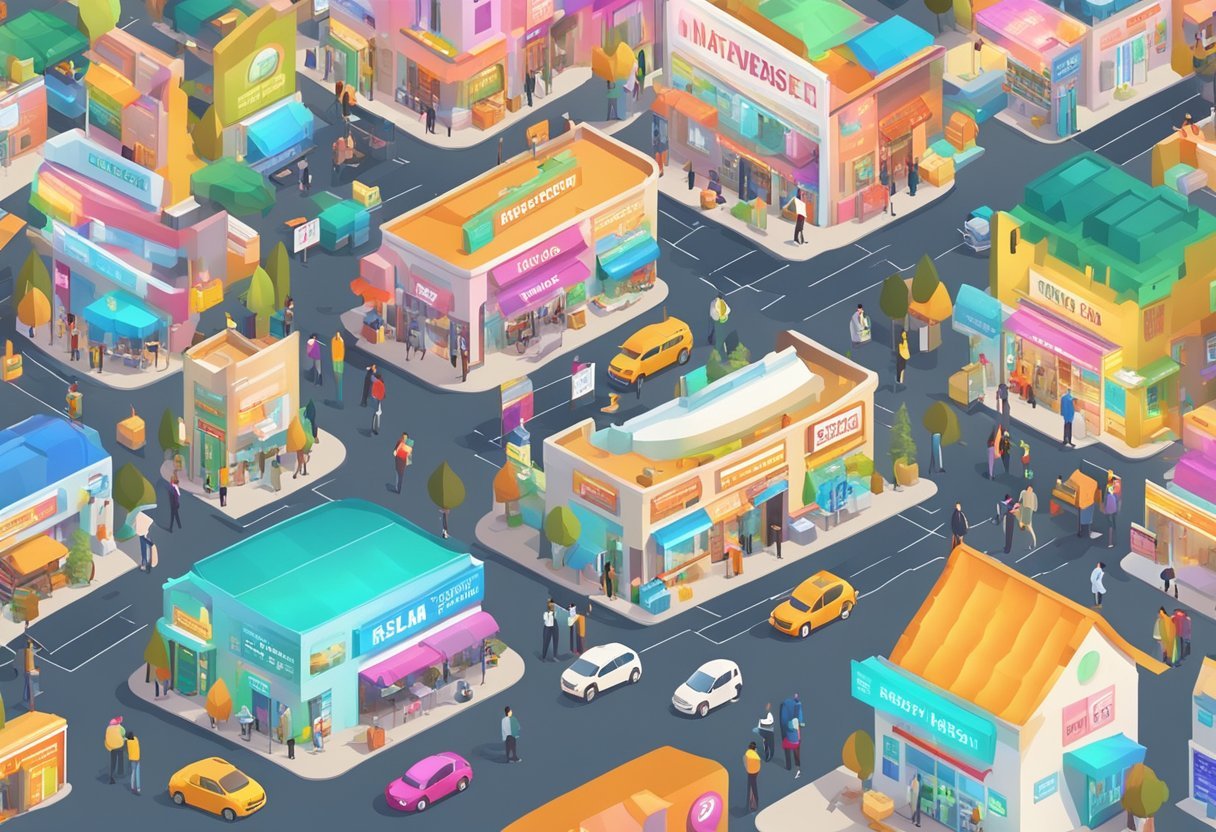The metaverse is a term that has been buzzing around the tech industry for a while now. It refers to a shared, immersive, and persistent virtual space that allows users to interact with each other in a 3D environment. The concept of the metaverse is not new, but it has gained more attention in recent years due to advancements in virtual and augmented reality technologies. So what does the metaverse look like?
The metaverse is essentially the next evolution of the internet, where users can experience life in ways that are not possible in the physical world. It is a digital space where people can socialize, learn, play, and conduct business. The metaverse is not just for gamers or developers; it is for everyone. The hope is that in the next decade, it will reach a billion people.
Virtual and augmented reality technologies are the backbone of the metaverse. Virtual reality creates a fully immersive experience, while augmented reality overlays digital information on the real world. The metaverse will combine these technologies to create a seamless virtual environment where users can interact with each other and digital objects. The internet will also play a significant role in the metaverse, providing the infrastructure for users to connect and interact with each other.
Defining the Metaverse
The metaverse is a term that has been used in science fiction for many years, but it has become increasingly relevant in recent times. It is a concept that has been discussed in the technology industry for a while, and it refers to a virtual world that is created by the convergence of the physical and digital worlds. The metaverse is a 3D social network that is more immersive than anything that has been seen before.
History and Evolution
The concept of the metaverse can be traced back to science fiction novels such as Snow Crash by Neal Stephenson, which was published in 1992. In this novel, the metaverse is a virtual reality world that people can visit and interact with. Since then, the concept has been explored in various forms of media, including movies, TV shows, and video games.
Over time, the technology has evolved to the point where it is now possible to create a metaverse that is more immersive and interactive than ever before. The metaverse is no longer just a concept in science fiction; it is becoming a reality.
Key Characteristics
The metaverse is characterized by several key features that set it apart from other virtual worlds. It is a shared, immersive, persistent, and 3D virtual space where humans experience life in ways they could not in the physical world. It is a place where people can socialize, learn, play, and more.
The metaverse is different from other virtual worlds in that it is more immersive and interactive. It is a place where people can interact with each other and with the environment in ways that are not possible in other virtual worlds.
Technological Foundations
The metaverse is built on a foundation of advanced technology. It is a complex system that requires a lot of computing power and advanced software to work properly. The metaverse is based on a combination of virtual reality, augmented reality, and other technologies.
The metaverse is still in its early stages, but it is expected to grow rapidly in the coming years. As the technology improves, the metaverse will become more immersive and interactive, and it will become a more important part of people’s lives.
The metaverse is a concept that is becoming increasingly relevant in the technology industry. It is a virtual world that is more immersive and interactive than anything that has been seen before. The metaverse is built on a foundation of advanced technology, and it is expected to grow rapidly in the coming years.
What does the metaverse look like?
This is what the metaverse looks like:
A Network of Interconnected Virtual Spaces
The metaverse appears as a vast and interconnected network of virtual spaces, each with its own unique design and purpose. These spaces range from realistic simulations of real-world environments to fantastical realms that defy the laws of physics. Users navigate these spaces as avatars, encountering diverse landscapes, cityscapes, and abstract constructs.
The cohesion between these virtual spaces is facilitated by interoperability standards, allowing users to move their digital identities and assets from one space to another seamlessly. This interconnectedness is what makes the metaverse a singular entity, despite being composed of numerous individual platforms and experiences.
A Hub of Social and Economic Activity
Within the metaverse, bustling marketplaces, social hubs, and collaborative workspaces resemble the vibrancy of real-world communities. Users gather in these spaces to conduct business, socialize, and collaborate on projects. Digital storefronts display a myriad of virtual goods and services, from fashion for avatars to virtual real estate.
Social venues host events like concerts, art exhibitions, and educational seminars, drawing crowds of avatars who interact and network much like people do in physical gatherings. The economic activity within the metaverse is facilitated by virtual currencies and blockchain technologies, which provide a secure and transparent way to transact.
A Canvas for User Creativity
The metaverse looks like a boundless canvas for user creativity, where individuals can create and modify their environments and experiences. Thanks to user-friendly creation tools, the metaverse is populated with user-generated content, ranging from simple customizations to elaborate constructions.
This democratization of content creation leads to a rich tapestry of styles and expressions, making the metaverse a visually diverse and ever-evolving landscape. The diversity of these creations reflects the global and multifaceted user base of the metaverse, contributing to its expansive and dynamic nature.
An Immersive Multi-Sensory Experience
Visually, the metaverse is an immersive multi-sensory experience, crafted with high-fidelity graphics, spatial audio, and haptic feedback, which collectively simulate the nuances of the physical world. Users experience a sense of presence as they explore lush forests, bustling cities, or otherworldly terrains.
The metaverse can also transcend visual and auditory experiences by integrating technologies that simulate touch and smell, further blurring the lines between the virtual and the real. This sensory richness is key to making the metaverse an engaging and believable space where users can lose themselves in the experience.
A Playground for Innovation and Experimentation
The metaverse looks like a playground for innovation and experimentation, where the only limit is the imagination of its inhabitants. It serves as a testing ground for new ideas in technology, design, and social interaction.
Cutting-edge technologies like virtual reality, augmented reality, and artificial intelligence are standard tools that shape the look and feel of the metaverse. This environment encourages risk-taking and creativity, leading to rapid advancements and the constant evolution of the metaverse’s appearance and capabilities.
A Reflection of Personal and Cultural Identity
The metaverse reflects the personal and cultural identities of its users, with avatars and environments that represent a wide array of backgrounds, interests, and styles. Users customize their avatars with clothing and accessories that express their individuality or cultural affiliations.
Similarly, the architecture and design of various spaces within the metaverse can reflect real-world cultures, historical periods, or entirely new aesthetics born from the digital realm. This diversity contributes to a rich visual and cultural mosaic that is continuously shaped by its users.
A Convergence of Physical and Digital Realities
Finally, the metaverse looks like a convergence of physical and digital realities, where elements from the real world blend seamlessly with virtual constructs. Through augmented reality, digital overlays enhance physical spaces with interactive, data-rich experiences.
Conversely, virtual reality spaces can be so detailed and responsive that they feel tangibly real. This merging of realities creates a hybrid landscape where digital and physical elements coexist and complement each other, offering users a unique and integrated experience that leverages the best aspects of both worlds.
Accessing the Metaverse
Hardware Requirements
Accessing the metaverse requires specific hardware requirements. The most common way to access the metaverse is by using a virtual reality (VR) headset. These headsets come with high-resolution displays and motion tracking sensors that provide an immersive experience to the users. Some of the popular VR headsets include Oculus, HTC Vive, and PlayStation VR.
Augmented reality (AR) technology is another way to access the metaverse. AR technology overlays digital content onto the real world, allowing users to interact with virtual objects in a real-world environment. AR technology can be accessed through smartphones and tablets that support AR technology.
Software Platforms
To access the metaverse, users need to have access to specific software platforms. These platforms provide the necessary tools and features to interact with the virtual world. Some of the popular software platforms include Second Life, VRChat, and AltspaceVR.
Social media platforms such as Facebook and Twitter are also integrating metaverse features into their platforms. This allows users to access the metaverse directly from their social media accounts.
Connectivity and Infrastructure
Accessing the metaverse requires a stable internet connection and adequate infrastructure. Users need a high-speed internet connection to access the virtual world without any lag or latency issues. The metaverse also requires a robust infrastructure to support the massive amounts of data that are being generated and transmitted.
Accessing the metaverse requires specific hardware and software requirements, as well as a stable internet connection and adequate infrastructure. VR and AR technology are the most common ways to access the metaverse, and social media platforms are also integrating metaverse features into their platforms.
Experiences in the Metaverse
The metaverse is a virtual world that offers various experiences to its users. It is a 3D social network that allows people to socialize, work, learn, and play in a virtual environment. Here are some of the experiences that a user can have in the metaverse.
Social Interaction and Avatars
One of the main experiences in the metaverse is social interaction. Users can create avatars that represent themselves and interact with other users in a virtual environment. The avatars can be customized to look like the user or anything else they want. Users can attend virtual concerts, attend meetings, and socialize with friends in a virtual world.
Gaming and Entertainment
Gaming and entertainment are also a significant part of the metaverse. Users can play video games with other users in a virtual environment. The games can be anything from puzzle games to first-person shooters. Users can also attend virtual concerts, watch movies, and attend other entertainment events in the metaverse.
Education and Work
The metaverse also offers opportunities for education and work. Users can attend virtual classes and learn in a virtual environment. They can also work remotely and collaborate with other users in a virtual workspace. The metaverse can provide a platform for people to work and learn without the need for physical presence.
The metaverse offers a wide range of experiences to its users. Social interaction, gaming, education, and work are just a few of the experiences that users can have in the metaverse. The virtual environment can provide a platform for people to connect, learn, and work without the need for physical presence.
Economic Aspects
The metaverse has the potential to revolutionize the global economy by creating new opportunities for businesses and individuals. There are several economic aspects of the metaverse that are worth exploring.
Virtual Economy and Marketplaces
One of the most significant economic aspects of the metaverse is the creation of virtual economies and marketplaces. The metaverse will allow businesses to create virtual storefronts and sell products and services to customers from all over the world. This will create new revenue streams for businesses and allow them to tap into new markets.
Virtual economies will also allow individuals to earn money by participating in the metaverse. For example, individuals can create and sell virtual goods, such as clothing, accessories, and even virtual real estate. This will create new opportunities for entrepreneurs and freelancers to earn a living in the digital economy.
Branding and Advertising
The metaverse will also create new opportunities for branding and advertising. Companies can create virtual experiences and events to promote their products and services. This will allow companies to reach a global audience and create more engaging experiences for customers.
The metaverse will allow companies to create virtual brand ambassadors, who can promote their products and services to customers in the metaverse. This will create new opportunities for influencers and content creators to earn money by promoting products and services in the digital economy.
Digital Ownership and NFTs
The metaverse will also create new opportunities for digital ownership and NFTs (non-fungible tokens). NFTs are unique digital assets that can be bought and sold in the metaverse. This will allow individuals to own and invest in virtual assets, such as virtual real estate and virtual art.
Digital ownership and NFTs will also create new revenue streams for artists and creators. For example, artists can create and sell virtual art, which can be owned and displayed in the metaverse. This will create new opportunities for artists to monetize their work in the digital economy.
The metaverse has the potential to create new economic opportunities for businesses and individuals. The creation of virtual economies and marketplaces, branding and advertising, and digital ownership and NFTs are just a few examples of the economic aspects of the metaverse. As the metaverse continues to evolve, it will be interesting to see how it impacts the global economy.
Challenges and Considerations
The metaverse is an exciting new concept that promises to revolutionize the way we interact with technology. However, like any new technology, it comes with its own set of challenges and considerations that must be taken into account.
Privacy and Safety
One of the biggest concerns with the metaverse is privacy and safety. With the potential for highly immersive experiences comes the potential for highly invasive data collection. Biometric data and personal information are used to increase the immersive experience of technology, but they come with serious privacy concerns. The metaverse poses risks to safety, including the potential for cyberbullying, harassment, and exploitation.
To address these concerns, it is important for developers to prioritize privacy and safety in the design of the metaverse. This can be achieved through the use of encryption, strong authentication mechanisms, and other security measures.
Interoperability and Standards
Another challenge with the metaverse is interoperability and standards. With so many different platforms and technologies involved, it can be difficult to ensure that everything works together seamlessly. This can result in a fragmented experience for users, which can ultimately hinder the growth and adoption of the metaverse.
To address this challenge, it is important for developers to work together to establish common standards and protocols. This will help to ensure that different platforms and technologies can communicate with each other effectively, and that users have a consistent experience across the metaverse.
Misinformation and Regulation
Finally, the metaverse poses challenges related to misinformation and regulation. With so much information available, it can be difficult to separate fact from fiction.
The metaverse is likely to be subject to a range of regulations and legal frameworks, which can be complex and difficult to navigate.
To address these challenges, it is important for developers to prioritize transparency and accountability in the design of the metaverse.
This can be achieved through the use of clear labeling and information-sharing mechanisms, as well as through collaboration with regulators and policymakers to ensure that the metaverse is subject to appropriate oversight and regulation.
Frequently Asked Questions
How is the metaverse visualized in current technology?
The metaverse is visualized in current technology through virtual and augmented reality. These technologies allow users to immerse themselves in a virtual world and interact with it in a more natural and intuitive way.
The visuals are often stunningly realistic, with high-quality graphics and lifelike environments. Users can explore these environments, interact with objects and other users, and even build their own virtual creations.
What are some prominent examples of metaverse environments?
There are several prominent examples of metaverse environments, including Second Life, Fortnite, and Roblox. These environments offer users a wide range of experiences, from socializing with other users to playing games and exploring virtual worlds.
Each environment has its own unique features and user base, but all share the common goal of creating a fully immersive and interactive virtual world.
Can you describe the user experience within the metaverse?
The user experience within the metaverse is highly immersive and interactive. Users can explore virtual worlds, interact with other users, and even create their own virtual content.
The experience is often highly social, with users able to interact with each other in real-time and engage in a wide range of activities. The user experience can be highly customizable, with users able to tailor their experience to their own preferences and interests.
What advancements might we expect in metaverse realism over the next decade?
Over the next decade, we can expect to see significant advancements in metaverse realism. This could include improvements in graphics and visual quality, as well as more advanced artificial intelligence and machine learning capabilities.
We may also see the development of new technologies, such as haptic feedback and virtual reality gloves, that could further enhance the user experience and make it even more immersive and interactive.
Who are the major players in the development of the metaverse?
There are several major players in the development of the metaverse, including Apple, Sony, Microsoft, and Facebook’s parent company Meta.
These companies are investing heavily in the development of virtual and augmented reality technologies, as well as in the creation of new metaverse environments and experiences. Other companies, such as Google and Amazon, are also exploring the potential of the metaverse and investing in research and development in this area.
What steps are involved in entering and navigating the metaverse?
Entering and navigating the metaverse typically involves several steps. First, users must have the necessary hardware and software, such as a virtual or augmented reality headset and compatible software.
They must then create an account and avatar within the metaverse environment, which allows them to interact with other users and explore virtual worlds. Once inside the metaverse, users can navigate using a combination of physical movement and virtual controls, such as a joystick or controller.




